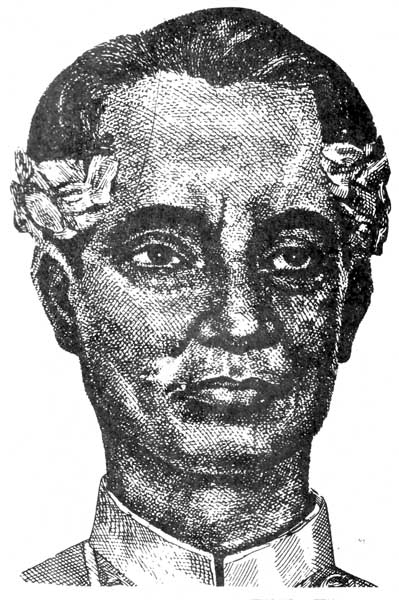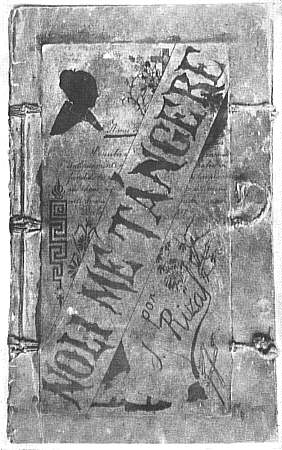|
Huseng Batute
José Cecilio Corazón de Jesús y Pangilinan (November 22, 1894 – May 26, 1932), also known by his pen name Huseng Batute, was a Filipino poet who used Tagalog poetry to express the Filipinos' desire for independence during the American occupation of the Philippines, a period that lasted from 1901 to 1946. He is best known for being the lyricist of the Filipino song Bayan Ko. Early life De Jesús was born on November 22, 1894 in Santa Cruz, Manila to Vicente de Jesús, the first health bureau director of the American occupation government, and Susana Pangilinan of Pampanga. He was christened José Cecilio de Jesús but he later dropped ''Cecilio'' and replaced it with the Spanish name ''Corazón'' (heart) because he said it best described his character. De Jesús spent his childhood in Santa Maria, his father's hometown. He completed his education at the Liceo de Manila, where he graduated in 1916. King of the Balagtasan On March 28, 1924, de Jesús and other leadin ... [...More Info...] [...Related Items...] OR: [Wikipedia] [Google] [Baidu] |
Santa Cruz, Manila
Santa Cruz is a district in the northern part of the City of Manila, Philippines, located on the right bank of the Pasig River near its mouth, bordered by the districts of Tondo, Binondo, Quiapo, and Sampaloc, as well as the areas of Grace Park and Barrio San Jose in Caloocan and the district of La Loma in Quezon City. The district belongs to the 3rd congressional district of Manila. History Spanish colonial era Prior to the arrival of the Spanish conquistadors to the Philippine Islands, the district of Santa Cruz was partly a marshland, patches of greeneries, orchards and partly rice fields. A Spanish expedition in 1581 claimed the territory and awarded to the Society of Jesus whose members are known as 'Jesuits'. The Jesuits built the first Roman Catholic church in the area where the present Santa Cruz Parish stands on June 20, 1619. The Jesuits enshrined the image of the Our Lady of The Pillar in 1643 to serve the pre-dominantly Chinese residents in the area. The image ... [...More Info...] [...Related Items...] OR: [Wikipedia] [Google] [Baidu] |
Balagtasan
''Balagtasan'' is a Filipino form of debate done in verse. Derived from the name of Francisco Balagtas, this art presents a type of literature in which thoughts or reasoning are expressed through speech. The first balagtasan took place in the Philippines on April 6, 1924, created by groups of writers to commemorate the birth of Francisco Balagtas. They made the first balagtasan with three sets of poets presenting a scripted defense. They based the form on earlier types of debates that also used poetic elements such as ''karagatan'', ''huwego de prenda'' and, ''duplo''. Balagtasan is participated by two or more protagonists who engaged in a debate on a selected subject. Each protagonist are to express their views in verse and with rhyming. Refutations shall also be done in the same manner. A judge, known as the ''lakandiwa'' if male or ''lakambini'' if female, will decide the winner of the balagtasan. The judge shall also announce the winner in verse and with rhyming. The partic ... [...More Info...] [...Related Items...] OR: [Wikipedia] [Google] [Baidu] |
1932 Deaths
Year 193 ( CXCIII) was a common year starting on Monday (link will display the full calendar) of the Julian calendar. At the time, it was known as the Year of the Consulship of Sosius and Ericius (or, less frequently, year 946 ''Ab urbe condita''). The denomination 193 for this year has been used since the early medieval period, when the Anno Domini calendar era became the prevalent method in Europe for naming years. Events By place Roman Empire * January 1 – Year of the Five Emperors: The Roman Senate chooses Publius Helvius Pertinax, against his will, to succeed the late Commodus as Emperor. Pertinax is forced to reorganize the handling of finances, which were wrecked under Commodus, to reestablish discipline in the Roman army, and to suspend the food programs established by Trajan, provoking the ire of the Praetorian Guard. * March 28 – Pertinax is assassinated by members of the Praetorian Guard, who storm the imperial palace. The Empire is auctioned off ... [...More Info...] [...Related Items...] OR: [Wikipedia] [Google] [Baidu] |
1894 Births
Events January–March * January 4 – A military alliance is established between the French Third Republic and the Russian Empire. * January 7 – William Kennedy Dickson receives a patent for motion picture film in the United States. * January 9 – New England Telephone and Telegraph installs the first battery-operated telephone switchboard, in Lexington, Massachusetts Lexington is a suburban town in Middlesex County, Massachusetts, United States. It is 10 miles (16 km) from Downtown Boston. The population was 34,454 as of the 2020 census. The area was originally inhabited by Native Americans, and was firs .... * February 12 ** French anarchist Émile Henry (anarchist), Émile Henry sets off a bomb in a Paris café, killing one person and wounding twenty. ** The barque ''Elisabeth Rickmers'' of Bremerhaven is wrecked at Haurvig, Denmark, but all crew and passengers are saved. * February 15 ** In Korea, peasant unrest erupts in the Donghak Peasant ... [...More Info...] [...Related Items...] OR: [Wikipedia] [Google] [Baidu] |
History Of The Philippines
Earliest hominin activity in the Philippine archipelago is dated back to at least 709,000 years ago. ''Homo luzonensis'', a species of archaic humans, was present on the island of Luzon at least 67,000 years ago. The earliest known anatomically modern human was from Tabon Caves in Palawan dating about 47,000 years. Negrito groups were the first inhabitants to settle in the prehistoric Philippines. By around 3000 BC, seafaring Austronesians, who form the majority of the current population, migrated southward from Taiwan. Scholars generally believe that these ethnic and social groups eventually developed into various settlements or polities with varying degrees of economic specialization, social stratification, and political organization. Some of these settlements (mostly those located on major river deltas) achieved such a scale of social complexity that some scholars believe they should be considered early states. This includes the predecessors of modern-day population centers ... [...More Info...] [...Related Items...] OR: [Wikipedia] [Google] [Baidu] |
Literature Of The Philippines
Philippine literature is literature associated with the Philippines from prehistory, through its colonial legacies, and on to the present. Pre-Hispanic Philippine literature was actually epics passed on from generation to generation, originally through an oral tradition. However, wealthy families, especially in Mindanao, were able to keep transcribed copies of these epics as family heirloom. One such was the ''Darangen'', an epic of the Maranaos. Classical literature in Spanish during the 19th Century On December 1, 1846, the first daily newspaper, '' La Esperanza'', was published in the country. Other early newspapers were ''La Estrella'' (1847), '' Diario de Manila'' (1848) and ''Boletin Oficial de Filipinas'' (1852). The first provincial newspaper was ''El Eco de Vigan'' (1884), which was issued in Ilocos. In Cebu City, ''El Boleaetín de Cebú'' (The Bulletin of Cebu) was published in 1890. On 1863, the Spanish government introduced a system of free public educ ... [...More Info...] [...Related Items...] OR: [Wikipedia] [Google] [Baidu] |
Francisco Santiago
Francisco Santiago Santiago (January 29, 1889 – September 28, 1947) was a Filipino musician, sometimes called ''The Father of Kundiman Art Song''. Life Santiago was born in Santa Maria, Bulacan, Philippines, to musically minded peasant parents, Felipe Santiago and Maria Santiago. In 1908, his first composition, ''Purita'', was dedicated to the first Carnival Queen, Pura Villanueva, who later married the distinguished scholar Teodoro Kalaw. He studied at the University of the Philippines (UP) Conservatory of Music, in its original campus in Manila, obtaining a degree in Piano in 1921, and a degree in Science and Composition in 1922. He went to the United States to pursue further education. He first obtained his master's degree at the American Conservatory of Music in June 1923, and finally a Doctorate degree at the Chicago Musical School in August 1924. He is the first Filipino musician to attain a doctorate degree. He became the director of the UP Conservatory of Musi ... [...More Info...] [...Related Items...] OR: [Wikipedia] [Google] [Baidu] |
Philippines
The Philippines (; fil, Pilipinas, links=no), officially the Republic of the Philippines ( fil, Republika ng Pilipinas, links=no), * bik, Republika kan Filipinas * ceb, Republika sa Pilipinas * cbk, República de Filipinas * hil, Republika sang Filipinas * ibg, Republika nat Filipinas * ilo, Republika ti Filipinas * ivv, Republika nu Filipinas * pam, Republika ning Filipinas * krj, Republika kang Pilipinas * mdh, Republika nu Pilipinas * mrw, Republika a Pilipinas * pag, Republika na Filipinas * xsb, Republika nin Pilipinas * sgd, Republika nan Pilipinas * tgl, Republika ng Pilipinas * tsg, Republika sin Pilipinas * war, Republika han Pilipinas * yka, Republika si Pilipinas In the recognized optional languages of the Philippines: * es, República de las Filipinas * ar, جمهورية الفلبين, Jumhūriyyat al-Filibbīn is an archipelagic country in Southeast Asia. It is situated in the western Pacific Ocean and consists of around 7,641 islands t ... [...More Info...] [...Related Items...] OR: [Wikipedia] [Google] [Baidu] |
Cockfighting
A cockfight is a blood sport, held in a ring called a cockpit. The history of raising fowl for fighting goes back 6,000 years. The first documented use of the ''word'' gamecock, denoting use of the cock as to a "game", a sport, pastime or entertainment, was recorded in 1634, after the term "cock of the game" used by George Wilson, in the earliest known book on the sport of cockfighting in ''The Commendation of Cocks and Cock Fighting'' in 1607. But it was during Magellan's voyage of discovery of the Philippines in 1521 when modern cockfighting was first witnessed and documented for Westerners by the Italian Antonio Pigafetta, Magellan's chronicler, in the Kingdom of Taytay. The combatants, referred to as gamecocks (not to be confused with game birds), are specially bred and conditioned for increased stamina and strength. Male and female chickens of such a breed are referred to as game fowl. Cocks possess congenital aggression toward all males of the same species. Wagers are ... [...More Info...] [...Related Items...] OR: [Wikipedia] [Google] [Baidu] |
Acacia
''Acacia'', commonly known as the wattles or acacias, is a large genus of shrubs and trees in the subfamily Mimosoideae of the pea family Fabaceae. Initially, it comprised a group of plant species native to Africa and Australasia. The genus name is New Latin, borrowed from the Greek (), a term used by Dioscorides for a preparation extracted from the leaves and fruit pods of ''Vachellia nilotica'', the original type of the genus. In his ''Pinax'' (1623), Gaspard Bauhin mentioned the Greek from Dioscorides as the origin of the Latin name. In the early 2000s it had become evident that the genus as it stood was not monophyletic and that several divergent lineages needed to be placed in separate genera. It turned out that one lineage comprising over 900 species mainly native to Australia, New Guinea, and Indonesia was not closely related to the much smaller group of African lineage that contained ''A. nilotica''—the type species. This meant that the Australasian lineage (by ... [...More Info...] [...Related Items...] OR: [Wikipedia] [Google] [Baidu] |





.jpg)
.jpg)
